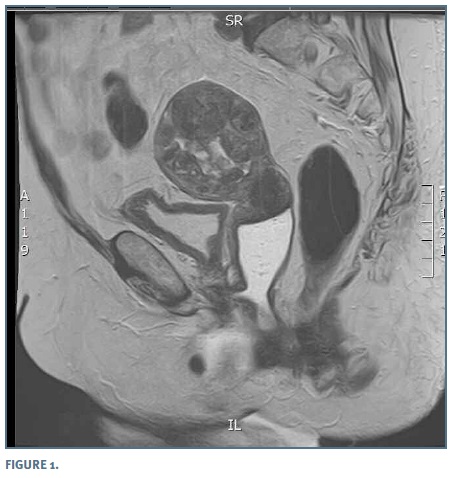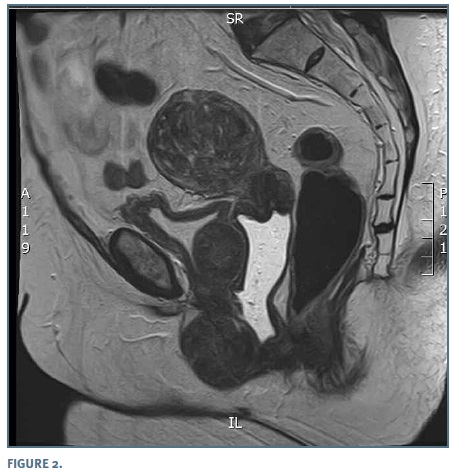Serviços Personalizados
Journal
Artigo
Indicadores
Links relacionados
Compartilhar
Acta Obstétrica e Ginecológica Portuguesa
versão impressa ISSN 1646-5830
Acta Obstet Ginecol Port vol.12 no.1 Coimbra mar. 2018
ISSUE IMAGE/IMAGEM DO TRIMESTRE
A disturbing vulvar mass - the tip of the iceberg
Massa vulvar - a ponta do iceberg
Bruna Ambrosio*, Paula Ambrosio**, Carlos Marques***
Hospital Vila Franca de Xira
*Interna de Especialidade de Ginecologia e Obstetrícia, Hospital Prof. Doutor Fernando Fonseca
**Assistente Hospitalar, Hospital de Vila Franca de Xira
***Assistente Hospitalar Graduado Sénior, Hospital de Vila Franca de Xira
Endereço para correspondência | Dirección para correspondencia | Correspondence
ABSTRACT
Uterine fibroids are benign monoclonal tumors that originates from the smooth muscle cells of the myometrium and are the most common solid pelvic tumors in women. In the differential diagnosis of vulvar masses we should considered Bartholin's cysts or abscesses, Bartholin's tumors, fibroids (usually fibroids of the round ligament), subcutaneous lipomas, inguinal hernia or adenomegaly. With this images we present a case of a vulvar mass caused by a fibroid, probably from the round ligament, which was a tip of the iceberg of an extensive pelvic leiomyomatosis.
Keywords: Vulvar mass; Round ligament; Uterine fibroids; Fibroids of the round ligament.
The authors present two impressive magnetic resonance images that shows several uterine fibroids (Figure 1) and three fibroids most likely to originate in the right round ligament (Figure 2) in a 71-year-old woman. These images were obtained throughout the investigation for a mass located at the right large vulvar lip, which we concluded to be the tip of the iceberg of an extensive pelvic leiomyomatosis. This woman, with no relevant history, was referred to our gynecology clinic for an asymptomatic vulvar mass. On observation, two nodular masses with hard consistency were identified on the right large lip and on the anterior vaginal wall with 40 mm and 30 mm, respectively. No
other anomalies were identified in the gynecological examination. A biopsy of the nodular formation of the right large lip was performed and the histological diagnosis was leiomyoma. Pelvic magnetic resonance imaging, with intravaginal gel, was performed and revealed a uterus compatible with adenomyosis and several leiomyomas, three well defined nodular formations with leiomyoma characteristics in the posterior wall of the bladder with 31 mm, in the anterior wall of the vagina near the large right lip with 42 mm and in the right vulvar area with 15 mm. As the patient was asymptomatic and refused surgical excision, no treatment was performed and she remains under gynecological surveillance at our clinic.
Uterine fibroids are the most common solid pelvic tumors in women, occurring in 20-40% of women of reproductive age. Extra uterine leiomyomas are rare and represent a diagnostic challenge. Unusual locations include the ovaries, bladder, urethra and vulva, the latter usually arising from the round ligament. There are few case reports and series with small numbers in the literature concerning round ligament fibroids and their exact incidence is unknown. Anatomically, the round ligament is about 10-14 cm long, begins at the uterine horn and extends through the inner inguinal ring along the inguinal canal to the large vulvar lips. It consists of smooth muscle cells, fibrous tissue, fat, blood vessels, lymph nodes and nerves. The fibroids may originate anywhere along the course of the round ligament and may be abdominal, inguinal or vulvar. The associated symptomatology is related to its location, size and growth rate. The etiopathogenesis of the fibroids of the round ligament is still a topic of debate and the main theories include the parasitic theory, which postulates that the parasitic myoma originates from a subserosal pedunculated myoma that becomes adherent to an adjacent structure and the theory that fibroids can develop directly from smooth muscle cells of the round ligament. The treatment is surgical excision, after which it is necessary to maintain long-term follow up.
With this case we illustrate a rare gynecological pathology - a vulvar mass caused by a leiomyoma, probably originated from the round ligament in a 71-year-old woman with an extensive pelvic leiomyomatosis.
Endereço para correspondência | Dirección para correspondencia | Correspondence
Bruna Ambrosio
E-mail: brambrosio@hotmail.com
Recebido em: 07/06/2017
Aceite para publicação: 29/08/2017
















